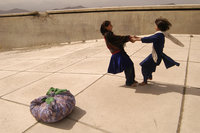The Photographer from Kabul

Photographers occasionally share the same lot as literary translators – people know their work, but not their names. Massoud Hossaini, for instance, has had his photos emblazoned across the front pages of international newspapers in Hong Kong, New York, and Germany. The 28-year-old Kabul native works in the Afghan capital as photographer for the AFP news agency.
The path he has taken, however, has been anything other than a simple one. Photography was forbidden under the Taliban, and college-level courses in photography were not – nor are they now – offered in Afghanistan. Only with the arrival of aid organizations after the fall of the Taliban did the situation change.
Rising from the ruins of Kabul
Massoud Hossaini completed a two-year training program in photojournalism offered by the "Aina" media initiative. In 2003, much lay in ruins, recalls his teacher. "We then gathered together old 35 mm cameras, even odd parts, whenever they fell into our hands. This way we were able to repair broken cameras. Some of the youngest course participants weren't even 18 yet."
His first hands-on experience with a camera was in Iran, where Massoud Hossaini and his family spent almost twenty years in exile because of war and then civil war in Afghanistan.
"At first, I would walk for hours through fields of rubble. I found children playing there and I tried to depict everything that I saw with my own colors," says Hossaini, remembering the months following his return. "Despite all the destruction, Kabul at twilight has its own special light and dust, creating a unique beauty and aesthetic," he explains.
Dangerous work
For quite some time now, the slightly built 28-year-old has had to travel to the sites of suicide attacks to earn his daily bread. "I constantly witness people dying. And I constantly have to suppress feelings of agitation and sadness."
In contrast to most of his international photographer colleagues, Hossaini is not insured should something happen to him. The photos he has taken of terrorist attacks have quite literally taken away his appetite. As a result of his work, he now only eats a vegetarian diet, says Massoud Hossaini.
A flash point between various perspectives

Despite all this, he loves his profession and sees himself as privileged. "What is so fascinating about my work is that within a single day I can portray the lives of simple people and also capture official political events."
His greatest desire is to complete studies abroad. He regards the situation in his homeland with mixed feelings. "The goal for the foreseeable future must be for the Afghan army and police to ensure security in the country themselves, while the international community provides them with support."
Not so long ago, Hossaini's photos were part of an exhibition in Berlin entitled "Unfinished Business." It attempted, in particular, to present life beyond the events making the headlines. "There are so many images of Afghanistan that the Western media will never show. These include pictures of normal, daily life."
Modern camera equipment
As a photographer working for an international news agency, Massoud Hossaini finds himself in a flash point between an Eastern and Western perspective. Recently, he was given the opportunity to work as an "embedded journalist" photographing US Army military camps. Previously, this would have been impossible for an Afghan journalist.
At the Goethe Institute in Kabul, where he has taken part in many training courses over the years, he now occasionally teaches workshops for the next generation of Afghan photographers. He has also shot photos for the German news magazine "Der Spiegel."
For the last few weeks he has been particularly happy – his agency has provided him with new camera equipment. Finally, he has the exact same equipment as his foreign colleagues, who fly in to Kabul.
Martin Gerner
© Qantara.de 2008
Translated from the German by John Bergeron
Qantara.de
The Destruction of the Buddhas of Bamiyan
The Iconoclasm of the Taliban
Seven years ago Taliban militias in Afghanistan destroyed the two largest standing Buddha statues in the world. The shrine at Bamiyan was part of our world cultural heritage, and the international public outcry was enormous – but the loss was worst of all for the art and history of Afghanistan. Nasim Saber reports
Khaled Hosseini's "Kite Runner"
Hollywood in Dari
With "Kite Runner" Khaled Hosseini has landed an international success. The film adaptation of his novel strove for authenticity. The film itself, however, has created quite a stir and elicited tension between various ethnic groups. Amin Farzanefar reports
Slide Show
Afghanistan - A Child's Eye View
Journalist Martin Gerner has made several trips to Afghanistan since 2004, reporting for various German radio stations and print publications. The photographs he has taken in the country represent an attempt to capture the everyday life of the Afghan people
